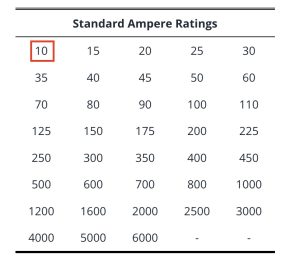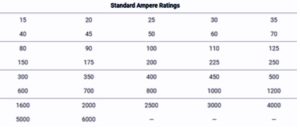How does the 2023 NEC change standard circuit breaker amp ratings?
Overview
 When sections of the National Electrical Code are updated, related sections must be updated as well. This is precisely the case with Table 240.6(A). To align with the newly permitted use of #14 AWG copper-clad aluminum circuit conductors for 10-ampere circuits from Section 240.4(D)(3), Table 240.6(A) has been updated to permit the use of 10-ampere circuit breakers. This makes using 10-ampere circuits more of a plausible reality. Because #14 AWG copper-clad aluminum is limited to 10-amperes, the previous minimum circuit breaker of 15-amperes was simply too big. This new addition promotes the use of 10-ampere circuit breakers, which will encourage manufacturers to make them.
When sections of the National Electrical Code are updated, related sections must be updated as well. This is precisely the case with Table 240.6(A). To align with the newly permitted use of #14 AWG copper-clad aluminum circuit conductors for 10-ampere circuits from Section 240.4(D)(3), Table 240.6(A) has been updated to permit the use of 10-ampere circuit breakers. This makes using 10-ampere circuits more of a plausible reality. Because #14 AWG copper-clad aluminum is limited to 10-amperes, the previous minimum circuit breaker of 15-amperes was simply too big. This new addition promotes the use of 10-ampere circuit breakers, which will encourage manufacturers to make them.
Applying the 2023 Code
Table 240.6(A) provides the list of standard ampere ratings for fuses and inverse time circuit breakers. While Section 240.6(A) has listed standard fuse sizes of 1, 3, 6, 10, and 601 amperes, in addition to the values in the table, the minimum size standard circuit breaker has been limited to 15-amperes. With the newly permitted use of #14 AWG copper-clad aluminum for 10-ampere circuits, the minimum standard size of 15-amperes wouldn’t work. The 2023 has updated Table 240.6(A) to include 10-ampere circuit breakers in the list of standard size circuit breakers. This will promote the use of 10-ampere branch circuits where permitted. One example of such use would be for LED lighting circuits. Because LEDs pull so little current, 10-ampere branch circuits fed with #14 AWG copper-clad aluminum can be an effective method of keeping material costs low, while still providing the same amount of lighting.
What’s New for the 2023 NEC?
2020 NEC
In the 2020 NEC Table 240.6(A) read as follows:

2023 NEC
In the 2023 NEC Table 240.6(A) now reads as follows:

